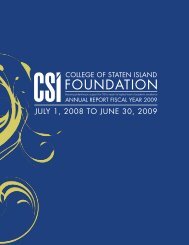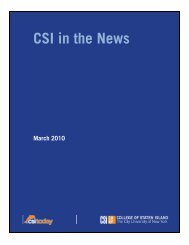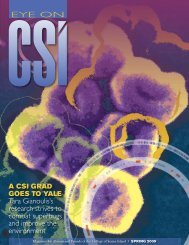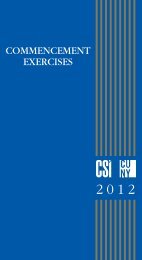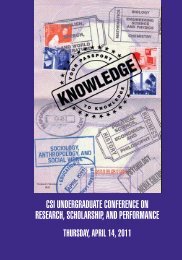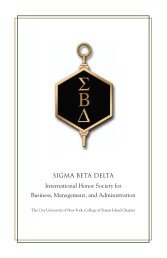CSI in the News - CSI Today
CSI in the News - CSI Today
CSI in the News - CSI Today
- No tags were found...
You also want an ePaper? Increase the reach of your titles
YUMPU automatically turns print PDFs into web optimized ePapers that Google loves.
Independent.ieFuhgeddaboutit: New York accent may be dy<strong>in</strong>g outTHE traditional New York accent – where residents pronounce coffee "cawfee" among o<strong>the</strong>r th<strong>in</strong>gs –could be on <strong>the</strong> wane, it has been claimed.Kara Becker, an assistant professor of l<strong>in</strong>guistics at Reed University, <strong>in</strong> a recent article for <strong>the</strong> NewYork Post, wrote that "Current l<strong>in</strong>guistic research f<strong>in</strong>ds that many of <strong>the</strong> def<strong>in</strong><strong>in</strong>g features of localspeech are los<strong>in</strong>g ground"."Research shows that not all accents are created equal <strong>in</strong> <strong>the</strong> US," she writes. "When Americans areasked to rank locations <strong>in</strong> descend<strong>in</strong>g order from most to least 'correct' speech, <strong>the</strong> New York Cityaccent is rated second to last (only <strong>the</strong> South rates lower). Speakers of <strong>the</strong> New York City accent, itturns out, are associated with a number of negative attributes, like be<strong>in</strong>g unfriendly and unk<strong>in</strong>d."She adds that New Yorkers <strong>the</strong>mselves suffer from "l<strong>in</strong>guistic <strong>in</strong>security".As a result, recent research has shown that <strong>the</strong>re are "big differences" across age groups <strong>in</strong> New York,where older speaker have <strong>the</strong> classic New York accent – "fuhgeddaboutit" – but younger speakers didnot replicate it.The present day New York accent comes from a varied history. The area has seen settlers from <strong>the</strong>Ne<strong>the</strong>rlands, England, Germany, and still ma<strong>in</strong>ta<strong>in</strong>s a prom<strong>in</strong>ent Italian, Irish and Jewish population.The <strong>in</strong>fluence of Yiddish is apparent.George Jochnowitz, emeritus professor of l<strong>in</strong>guistics at <strong>the</strong> College of Staten Island, Long Island, toldThe Times: "Both Yiddish and Italian did not make a dist<strong>in</strong>ction between <strong>the</strong> pronunciation of 'ng' <strong>in</strong>s<strong>in</strong>ger and f<strong>in</strong>ger."Long Island for example, was "Lawn Gyland". But, he claims such sounds have now faded from NewYork City.-Page 35 of 161



